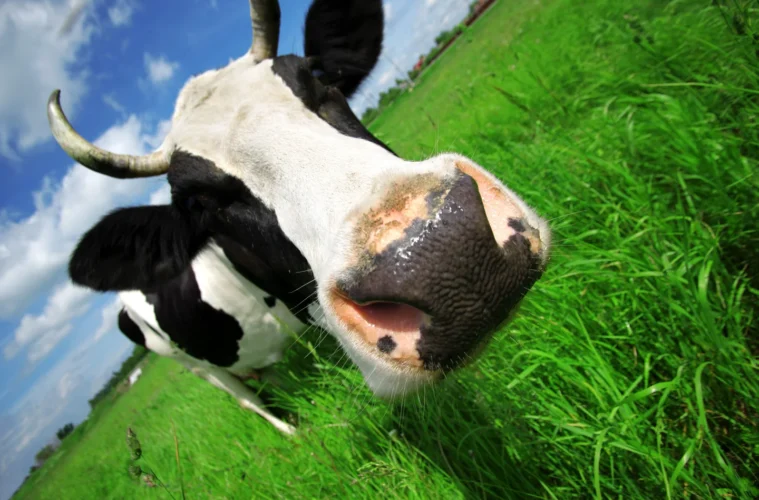If you feed hemp to cows, will they get stoned? German researchers studying the effects of feeding dairy cows THC, the psychoactive compound found in marijuana and hemp (but in significantly lower amounts) made a few intriguing discoveries, according to a study published in the journal Nature Food.
Typically, cows eat a steady diet of hay and corn. But a set of Holstein cattle were given hemp in their feed, and researchers said the bovines were more chilled out, salivated and yawned more often, and frequently engaged in whimsical tongue play, the study said, according to the New York Times. The cattle also spent more time lounging in the barn as they digested their food and pondered the meaning of life.
Interestingly, the cows didn’t exhibit any signs of the munchies or binge eating.
While the cows’ behavioral changes were notable, the NYT also says they’re the unintended consequences of an experiment by researchers at the German Federal Institute for Risk Assessment. Their goal was to learn more about how hemp with minuscule amounts of THC in it might impact dairy production. The study’s researchers also wanted to know whether THC, or delta-9-tetrahydrocannabinol, could find its way to humans through milk.
Researchers say the naturally occurring, but limited levels of THC in the hemp stocks did not affect the 10 cows in the study. But once the animals ate hemp buds and leaves — parts of the plant that contain higher concentrations of the THC — researchers noted that the cows ate less and that milk production dropped significantly.
Moreover, THC made its way into cow’s milk, sometimes at levels that exceeded consumption limits set by European food safety regulators. (The US doesn’t have a comparable standard yet. The CDC advises new mothers to avoid marijuana and CBD products while breastfeeding, but the research on the effects of passing trace amounts to an infant remains unclear.)
THC became undetectable in milk soon after the hemp was removed from the cows’ diet. Signs of intoxication, including red eyes, runny noses, and an “unsteady gait” and “abnormal posture” subsided after two days of the cows returning to their regular diets of corn and hay.
Dr. Robert Pieper, a lead author of the study, said it’s unclear whether the decline in milk output was caused by THC or by one of the dozens of other cannabinoids found in hemp plants. More research is needed, he said.
“Hemp is a very versatile and valuable crop, but we have to be careful when considering whether to feed it to food-producing animals,” said Dr. Pieper, who heads the food chain safety division at the German Federal Institute.
The findings are largely in sync with other recent studies conducted in the United States that involved hemp and livestock. Researchers at Oregon State University who fed hemp to sheep found small amounts of THC in the animal’s muscle and fat, but the chemical vanished several weeks after the hemp was removed from their diet.
Serkan Ates, an associate professor at Oregon State’s College of Agricultural Sciences, said the studies conducted on sheep and dairy cows convinced him of a few downsides to introducing hemp into the diets of farm animals, especially given the soaring costs of conventional feed. “The nutritional value of hemp is really high, but most of it is ending up in landfill or being composted,” he said.
In studies done at Kansas State University, THC showed up in the plasma of cattle that ate hemp, but researchers also discovered that the animals were more relaxed, according to biomarkers that indicate stress levels. Similar to the German study, the animals also spent more time lying down with their barn mates.
Michael Kleinhenz, an assistant professor of beef production medicine at Kansas State who participated in the studies, said the findings suggested that even trace amounts of THC in hemp might have practical benefits for animals. For one, steers that spend more time lounging around tend to put on more weight, but a happy cow is also a healthier one, according to Professor Kleinhenz.
He cited preliminary research suggesting that reducing stress can help alleviate the negative effects of shepherding cattle through the doldrums of life on the feedlot before they are slaughtered. The experience is not pleasant, and it’s usually followed by a spike in respiratory illness and other health problems on the feedlot.
These studies come at a time when hemp farmers in the US are stuck with a crop glut. The surplus is a result of poor regulatory infrastructure that’s led to roughly 24,000 tons of organic matter left over after CBD and other cannabinoids are extracted from the cannabis.
Despite Congress legalizing hemp via the 2018 Farm Bill, leading to the expansion of the CBD oil and other cannabinoid businesses. However, there are still limitations on how hemp can be used in society. For example, hemp cannot legally be used in animal feed.
“Hemp farmers are struggling to deal with tons of this unwanted biomass,” Jonathan Miller said to the NYT. He’s on the general counsel of the US Hemp Roundtable, an industry group.
The debate on whether to use hemp in animal feed is still in its infancy. Hopefully, data will prove its utility for animals, otherwise metric tons of hemp will go to waste.


